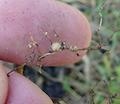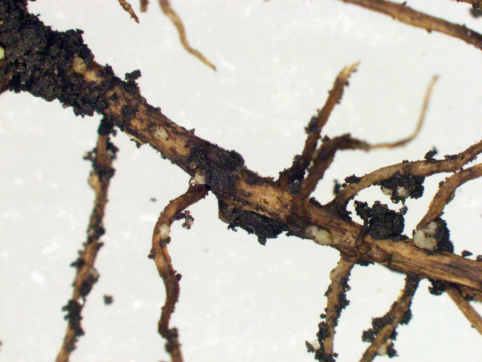June 13, 2018

Source: Iowa State University
By Dr. Greg Tylka, Department of Plant Pathology and Microbiology
The soybean cyst nematode (SCN) is a major pathogen of soybean in Iowa and throughout the Midwest. Damage often goes unrecognized until lower-than-expected yields are harvested because above-ground symptoms may not be obvious, especially when adequate or excess rainfall occurs during the season. A key way to check fields for this pest is to dig soybean roots and look for the small, round, white adult SCN females. It typically takes 5 to 6 weeks or more after planting for the first SCN females of the growing season to develop and appear on roots.
SCN Females Already Apparent on Roots
Soybean plants from two fields in central Iowa were brought to Iowa State University on June 5. Numerous adult SCN females were observed on the roots (see figure). The soybeans were planted on May 10.
The appearance of SCN females on soybean roots just 26 days after planting is as early as I have seen. The rapid development of SCN females likely is due to the very warm temperatures that occurred in Iowa in May.

Adult soybean cyst nematode (SCN) females on soybean roots collected on June 5, 2018,
from a field in central Iowa that was planted on May 10, 2018.
There are more than a dozen SCN females (cream-colored objects) on the roots shown in this image.
Rapid Development May Lead to Large Increases in SCN Numbers
Discovery of SCN females on roots in early June doesn't bode well for the remainder of the season. The appearance of the white, adult SCN females on roots indicates that the first generation of the nematode is being completed. The nematode will continue to reproduce in successive generations throughout the growing season, into the fall. And if above-average temperatures persist, there may be more generations of SCN produced in the 2018 growing season than in seasons with cooler temperatures. Each SCN female produces 250 or more eggs and when numerous generations occur in a single growing season, SCN population densities (numbers) can “blow up” to disastrous proportions in a single year.
Soybean Resistance to SCN is Fading
The females observed on roots described above were on two different SCN-resistant soybean varieties. This point illustrates that many SCN populations in Iowa have built up the ability to reproduce on SCN-resistant soybean varieties.
It is not uncommon to find a few SCN females on the roots of SCN-resistant soybean varieties, but it is troubling to see so many SCN females on the roots of resistant soybean varieties so early in the season. There are more than a dozen SCN females on the few roots shown in the image above.
Managing SCN
Iowa State University recommends growing resistant varieties that provide good SCN control in rotation with the nonhost crop corn and consider using nematode-protectant seed treatments when growing soybeans.
Information on how well resistant soybean varieties control SCN numbers is available at www.isuscntrials.info. Also, more information about the biology and management of SCN is available at www.soybeancyst.info, www.soybeanresearchinfo.com/diseases/scn.html, and www.TheSCNCoalition.com
You May Also Like




